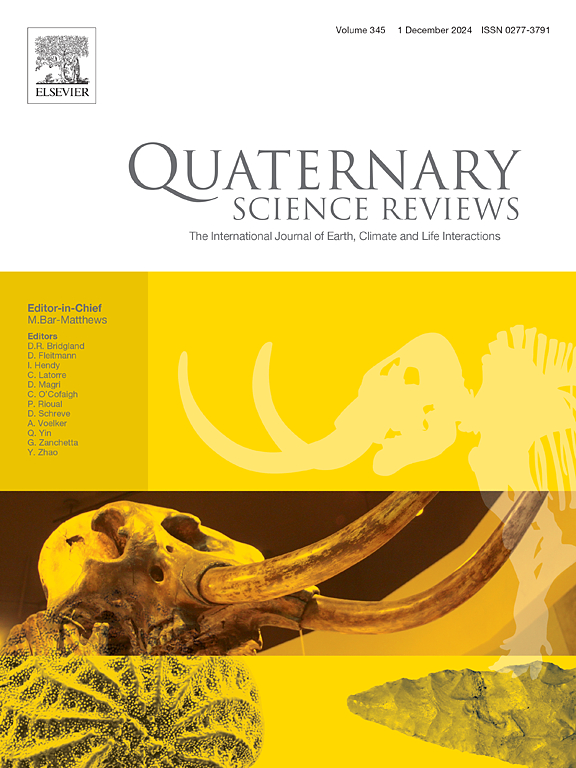Winter-spring temperature reconstructed from tree-ring earlywood blue intensity in southern Anhui province of China
IF 3.2
1区 地球科学
Q1 GEOGRAPHY, PHYSICAL
引用次数: 0
Abstract
Winter-spring coldness exerts strong impacts on socioeconomic activities and crop production in southeastern China. Tree-ring based temperature reconstructions in southeastern China provides a long context of current temperature change, still lack study in Anhui province. This study developed tree ring width (TRW), earlywood blue intensity (EWBI), latewood blue intensity (LWBI) and delta blue intensity (difference between EWBI and LWBI, ΔBI) chronologies using the tree rings of Pinus taiwanensis in Dalishan Mountain, southern Anhui province. The strongest correlation (r = 0.7, p < 0.05) is found between EWBI and current January–May mean temperature during 1955–2021. We thus reconstructed winter-spring (January–May) mean temperature from 1846 to 2021 using EWBI, which explained 49 % (adjust 48.2 %) of the instrumental variances. The reconstructed temperature series revealed a warm period (2004–2021) and two cold periods (1943–1945, 1948–1967). Comparisons of temperature series with surrounding areas show similar changes, particularly in line with warming trends after the 1940s. Winter-spring temperature in the subtropical zone is significantly positively correlated with SST of the tropical western Pacific and Indian Ocean regions, indicating temperature variation due to quasi-biennial oscillation (QBO), pacific decadal oscillation (PDO), or solar activity. In the reconstructed mean temperature series, it was found that it was affected by a total of 8 volcanic eruptions. The vector wind in lower troposphere analyses show that the extreme cold and warm years are not only related to the northeast wind (wind direction and strength) and tropical ocean temperature (SST), but also to the Tibetan Plateau cold high. The study result indicates the better application value of BI in the further study of subtropical tree rings.
安徽南部树木年轮早期蓝强度重建的冬春温度
冬春寒冷对中国东南部地区的社会经济活动和作物生产具有强烈的影响。基于树木年轮的中国东南部温度重建提供了当前温度变化的长期背景,但在安徽省仍缺乏研究。以皖南大山台湾松木年轮为研究对象,建立了树轮宽度(TRW)、早蓝强度(EWBI)、晚蓝强度(LWBI)和三角洲蓝强度(EWBI与LWBI之差,ΔBI)年代学。相关性最强(r = 0.7, p <;在1955-2021年期间,EWBI与当前1 - 5月平均气温之间存在0.05)。因此,我们使用EWBI重建了1846年至2021年冬春(1月至5月)的平均温度,这解释了49%(调整48.2%)的工具方差。重建的温度序列显示一个暖期(2004-2021)和两个冷期(1943-1945、1948-1967)。与周边地区的温度序列比较显示出类似的变化,特别是与20世纪40年代以后的变暖趋势一致。亚热带冬春温度与热带西太平洋和印度洋地区海温呈显著正相关,表明温度变化可能与准两年代际涛动(QBO)、太平洋年代际涛动(PDO)或太阳活动有关。在重建的平均温度序列中,发现它共受到8次火山爆发的影响。对流层低层矢量风分析表明,极端冷暖年不仅与东北风(风向和强度)和热带海洋温度(海温)有关,还与青藏高原冷高压有关。研究结果表明,BI在进一步研究亚热带树木年轮方面具有较好的应用价值。
本文章由计算机程序翻译,如有差异,请以英文原文为准。
求助全文
约1分钟内获得全文
求助全文
来源期刊

Quaternary Science Reviews
地学-地球科学综合
CiteScore
7.50
自引率
15.00%
发文量
388
审稿时长
3 months
期刊介绍:
Quaternary Science Reviews caters for all aspects of Quaternary science, and includes, for example, geology, geomorphology, geography, archaeology, soil science, palaeobotany, palaeontology, palaeoclimatology and the full range of applicable dating methods. The dividing line between what constitutes the review paper and one which contains new original data is not easy to establish, so QSR also publishes papers with new data especially if these perform a review function. All the Quaternary sciences are changing rapidly and subject to re-evaluation as the pace of discovery quickens; thus the diverse but comprehensive role of Quaternary Science Reviews keeps readers abreast of the wider issues relating to new developments in the field.
 求助内容:
求助内容: 应助结果提醒方式:
应助结果提醒方式:


